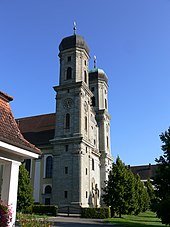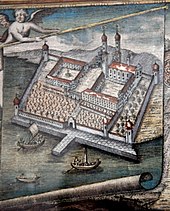Friedrichshafen Castle Church
The Evangelical Lutheran Castle Church is located at the end of Klosterstrasse in Friedrichshafen and on the Lake Constance circular route and is an important building along the Upper Swabian Baroque Route . Its two 55 m high towers are a striking landmark of the city of Friedrichshafen. When it was built in 1702, it was the largest baroque church on Lake Constance .
history
The church, whose history is inextricably linked with that of the Hofen monastery , was built between 1695 and 1702 according to plans by Christian Thumb as part of the monastery building. The church was founded on October 8, 1702 consecrated . In 1803 the imperial monastery Weingarten , to which the monastery Hofen belonged, was secularized and came to Orange-Nassau . In 1804 it was confiscated by Austria and in the Peace of Pressburg was transferred to Württemberg by Napoleon in 1806 . The village of Hofen was merged with the city of Buchhorn to form the newly founded city of Friedrichshafen in 1810/11. The monastery complex with the church was assigned to the Württemberg court domain chamber, which made the church building available to the newly founded Evangelical parish of Friedrichshafen in 1812. During this time, apart from the confessionals and the demolition of a ridge turret over the east wall, the church was not significantly changed.
The church was badly damaged in a bombing raid during World War II on April 28, 1944. The south tower burned out, the roof structure was completely destroyed. It was not until 1947/48 that an emergency roof could be built with Swiss help. The stucco and the ceiling paintings of the main nave, the pews and the organ were destroyed by the moisture that had already penetrated. During the reconstruction from 1949 to 1954, Josef Schnitzer added the missing stucco in a simpler form based on old photos. The church renovation was completed in 1959 with the completion of the church roof. The church was rededicated for worship on July 1, 1951.
Church building
The east-facing church with the distinctive double tower facade follows the tradition of the Vorarlberg cathedral scheme . It represents a further development of the spatial idea of the Obermarchtal monastery . It also shows the art of the Wessobrunn building and plastering school. The architectural style of the early baroque with its strict lines is still based on the time of the Renaissance. The space is structured by pillars and galleries on the long sides. The incidence of light is made possible by rows of windows one above the other.
Furnishing
The church was equipped with stucco work by father and son Schmuzer . The ceiling paintings by the Rottweiler artist Joseph Hildebrandt are executed on canvas. The pulpit by Martin Höfele from 1702 with the pulpit figures by Ursus Byß and the altars with superstructures by Christoph Gschanig and altar leaves by Johann Michael Feuchtmayer are noteworthy . The church's courtyard box is located in the south-west corner and can be entered via the palace building. The choir stalls were made by Martin Höfele and were also equipped with attachments by Feuchtmayer. The high altar structure from 1711/12 comes from Franz Schmuzer and received an altar sheet depicting the crucifixion of Christ, presumably from Franz Carl Stauder . The confessionals were converted into sacristy cabinets after secularization .
organ
Originally the church was equipped with a main organ (1698–1702) and a choir organ (1706) by the Augsburg organ builder Christoph Löw . These were given to Tuttlingen or Kehlen after the secularization . From then on the organ of the former parish church in Altdorf served as the organ, which had to be demolished for legal reasons until Carl Gottlieb Weigle built a new instrument in 1867.
Today's three-manual organ from 1970 with its 42 sounding stops comes from the organ building company Friedrich Weigle. A comprehensive overhaul is currently planned (2017). The electric console is renewed and the sound of the work is changed in terms of disposition and intonation without completely giving up the neo-baroque sound characteristics. She has the following disposition:
|
|
|
|
||||||||||||||||||||||||||||||||||||||||||||||||||||||||||||||||||||||||||||||||||||||||||||||||||||||||||||||||||||||||||||||||||||||||||
- Pair : III / II, III / I, II / I, I / P, II / P, III / P
- Playing aids : 4 free combinations , 2 pedal combinations, crescendo kick , swell kick , tongue holder 4 tremulants
Web links
Individual evidence
- ↑ a b c d e Friedrichshafen City Archives (ed.): Geschichtspfad Friedrichshafen. City of Friedrichshafen, Friedrichshafen 2001, ISBN 3-89549-301-5 .
- ↑ a b Lutz title in: Churches in Friedrichshafen, history and art. Robert Gessler, Friedrichshafen 1989, ISBN 3-922137-55-5 , p. 180 ff.
- ↑ a b c d e Georg Wieland in: Churches in Friedrichshafen, history and art. Robert Gessler, Friedrichshafen 1989, ISBN 3-922137-55-5 , pp. 239-241.
- ↑ Information on the castle church on the parish website, accessed on September 27, 2017
- ^ Leopold Neff in: Churches in Friedrichshafen, history and art. Robert Gessler, Friedrichshafen 1989, ISBN 3-922137-55-5 , p. 126.
- ↑ Information on organ renovation on the website of the parish, accessed on September 27, 2017
- ↑ Information on the organ at www.evkirchenmusik-fn.de, accessed on September 27, 2017
Coordinates: 47 ° 39 ′ 0.8 ″ N , 9 ° 27 ′ 51.7 ″ E






